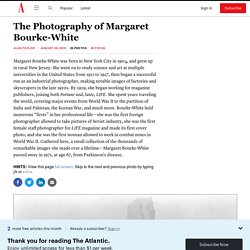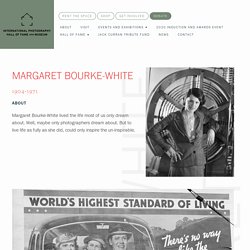

The Photography of Margaret Bourke-White. Margaret Bourke-White was born in New York City in 1904, and grew up in rural New Jersey.

She went on to study science and art at multiple universities in the United States from 1921 to 1927, then began a successful run as an industrial photographer, making notable images of factories and skyscrapers in the late 1920s. By 1929, she began working for magazine publishers, joining both Fortune and, later, LIFE. She spent years traveling the world, covering major events from World War II to the partition of India and Pakistan, the Korean War, and much more.
Bourke-White held numerous “firsts” in her professional life—she was the first foreign photographer allowed to take pictures of Soviet industry, she was the first female staff photographer for LIFE magazine and made its first cover photo, and she was the first woman allowed to work in combat zones in World War II. The National Endowment for the Humanities. “Her accomplishments would have been significant in any historical time, no matter who had done them—the fact that she was a woman in those very early prefeminist years makes them all the more remarkable,” says author and professor Lynne Iglitzin.

Iglitzin, who is also a distant relative of White’s, presents “Trailblazing Photojournalist: Margaret Bourke-White,” a Speakers Bureau program of Humanities Washington, at the Spokane Valley Library and North Spokane Library on November 5, Ellensburg Public Library on November 10, and the Richland Public Library on November 17. Bourke-White took an interest in photography at an early age alongside her father, Joseph, an amateur photographer, who often used Margaret as his assistant, to help develop pictures in their bathroom.
At fifteen, Bourke-White turned a summer job as a camp counselor into a photography business by photographing the campers next to their bunks and sending the printed cards to the campers’ families for five cents a card. The Pioneering Photography of Margaret Bourke-White. PHOTOGRAPHY VIEW; Her Magazine Images Brought the World Home. Some of these contradictions can be seen in a retrospective exhibition of more than 100 vintage Bourke-White prints at the International Center of Photography (1130 Fifth Avenue, at 94th Street) through May 1.

Others can be read about in ''Margaret Bourke-White,'' a biography published last year by Addison-Wesley and written by Vicki Goldberg, who also organized the exhibition and wrote the catalogue essay. Ms. Goldberg, who now ranks as our reigning Bourke-White expert, is not oblivious to the disparities and inconsistencies in the photographer's life. Bourke-White was ''a woman who needed to be liked,'' she writes in her biography, albeit one who ''left behind her a wide swath of injured wives.'' But Ms. The Photography of Margaret Bourke-White. <img data="block-image" data-id=5351816 desc="Asset ID: 1138514.

" caption="Margaret Bourke-White with camera (Photo by Margaret Bourke-White/The LIFE Picture Collection)" title="" src=" alt="Margaret Bourke-White with camera (Photo by Margaret Bourke-White/The LIFE Picture Collection)" /> Margaret Bourke-White with camera (Photo by Margaret Bourke-White/The LIFE Picture Collection) “Photography is a very subtle thing. You must let the camera take you by the hand, as it were, and lead you into your subject.” Margaret Bourke-White (1904-1971) led the rest of us by the hand on many occasions. In 1929 she did the lead story for the first issue of Fortune, and the next year was the first Western photographer allowed into the Soviet Union. In 1936 she collaborated with future husband Erskine Caldwell on a book documenting the rural poor of the South, You Have Seen Their Faces. She was America’s first accredited woman photographer in WWII, and the first authorized to fly on a combat mission. International Photography Hall of Fame.
Although her father was very fond of photography and was always experimenting with lenses and other gadgetry, Margaret did not pick up a camera until after her father’s death.

In 1921, Margaret had enrolled in classes at Columbia University in New York to study art. Her mother bought Margaret her first camera that year. It was a 3 ¼ x 4 ¼ Ica Reflex. The camera had cost her mother $20 and it had a cracked lens. She took a one-week course under Clarence H. Her photographs were a huge success. The beauty and lore of industry, which Bourke-White had seen as a child were reignited when she moved to Cleveland. While working in the Soviet Union recording the industrialization, Margaret began to notice the people. Erskine Caldwell was looking for a photographer to accompany him on a trip to the South where he was going to write a second book.
In 1941, Caldwell and Bourke-White went to the Soviet Union. During the Korean War, Margaret started noticing the symptoms of Parkinson’s disease. The Photography of Margaret Bourke-White.